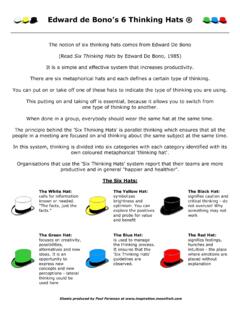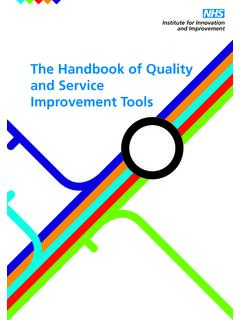Transcription of 7 STEPS TO SAFE PERSONAL & EFFECTIVE CARE - ELHT …
1 7 STEPS TO. safe PERSONAL & EFFECTIVE . care . A Quality Improvement Guide 1. Contents Page 3. Introduction 5. Define Project Aim 7. Discover 9. Measure 12. Investigate change options 14. Test out the change 15. Implement the change 17. Celebrate, Spread and Sustain 19. Toolkit 41. Useful National Guides 2. Introduction PERSONAL EFFECTIVE . safe . Patient centred Evidence based Harm Free Respect & dignity Reliably delivered WHY FOCUS ON QUALITY IMPROVEMENT (QI)? Quality improvement (QI) in the NHS focuses on how healthcare can continuously improve to deliver better care to our patients, in a timely manner, with compassion and high standards. Improvements, sparking creativity, testing new ideas and reflecting on the services we provide is everyone's business. QI is evidence based systematic approach to improving processes of care for measurable and better outcomes.
2 All staff at East Lancashire Hospital Trust (ELHT) are encouraged to apply the ELHT approved QI improvement methodology when implementing changes or testing new ideas. KEY LEVELS OF A LEARNING JOURNEY. Lead or senior level staff Useful National Guides links on page 40 will provide further detailed guidance about current frameworks that exist to support spread and sustainability. Please note there is also a "quick guide" to 7 STEPS if you are already familiar with QI techniques Practitioner level and/or involved in leading a team to improve service delivery This document is a coaching guide for you. It is particularly relevant if you have operational responsibility over more than one service/setting Foundation level or staff working in clinical settings with exposure to improvement This document is a coaching and information guide for you.
3 It will help you understand what underpins successful implementation and spread of QI initiatives Administrative/support service role This guide can provide support in testing new ideas and support achievements that are successful, EFFECTIVE and embedded into daily practice. TOOLKIT SECTION. The toolkit section includes readily available templates, forms and tools that form each of the 7 STEPS . These will help you apply the 7. STEPS in a practical way, with easy access and simplified versions to support a broad range of projects. There is a Useful National Guides section at the end which provides further reading and information about the theory behind some of the tools applied in the 7. STEPS . WHAT YOU WILL ACHIEVE BY USING 7 STEPS ? By applying a standardised approach to improvements, considering several fundamental aspects and having the tools to apply changes to daily practice; improvements to your service should be successful, productive and rewarding to both patients and staff.
4 7 STEPS will help you tackle the obstacles along the way in a structured format. GOOD LUCK ON YOUR JOURNEY. 3. 4. step 1: DEFINE PROJECT AIM. Aim of this stage: Understand why an improvement is needed, scope out key stakeholders and create a project aim which is SMART. Analyse the problem by talking and listening to those involved. Once you have a clear understanding, support is needed from those involved, as this will increase team engagement and provide a stable platform for developing your project. IDENTIFY AND UNDERSTAND STAKEHOLDERS. Identify a small number of key individuals, both at a senior and operational level, who could support, advocate or give advice on the project. The stakeholder analysis in the toolkit will help you identify them. GO TO TOOLKIT: STAKEHOLDER ANALYSIS/MAPPING. Consideration to how key stakeholders and staff are affected by the proposed project or change will determine the level of engagement needed.
5 For larger scale projects a project sponsor and involvement from a senior level (Chief Executive or Executive Team) is necessary to champion your project and provide strategic direction. Understanding different views and emotions from key stakeholders and knowing how to manage them will contribute to the success of your idea. Consider different methods of communication with them and the level of engagement required throughout the whole project. People are usually quite open about their views - asking their opinions can be the first step in building a successful partnership for the project. Once you have identified key stakeholders, if appropriate, you may need to form an improvement team who will assist in certain aspects of the 7 STEPS , driving the project forward and offer different service perspectives. DEFINING A SMART AIM.
6 An aim statement should be SMART: Specific, Measurable, Achievable, Realistic and Time-bound. Be clear in outlining: What you are trying to achieve, for whom by when and why. This will ensure everyone is working towards the same aim and expectation. A good aim statement can help to motivate people about your project as being something worthwhile, measurable and achievable. Be prepared to refocus the aim Refocusing the aim could be a conscious decision to work on a smaller part of the system to make the initial change manageable. Refocusing an aim usually occurs as you develop and discover more about the change needed. GOOD AIM: Achieve a 20% reduction in emergency POOR AIM: Improve cancer services to deliver timely care . admissions for heart failure patients by July 2013 Doesn't clearly state what the change will be, which service area Provides a clear a numerical target to aim for, but what is or who is responsible.
7 Is it for all types of cancers? The project the 20% measured against? Is it 20% reduction from the aim must stipulate how much the service is going to be improved, previous year? Is it realistic? Could it be achieved? when it is going to be completed and what is the impact of the improvement. DRIVER DIAGRAM. A driver diagram can be used to plan improvement project activities. It captures an entire change programme in a single diagram and provides a measurement framework for monitoring progress. GO TO TOOLKIT: DRIVER DIAGRAM TEMPLATE and EXAMPLE. 1. THE AIM: Input the aim you are trying to achieve. It needs to be measurable and specific. 2. PRIMARY DRIVERS: What are the biggest driving forces that will need to be considered to help achieve your aim? The primary drivers need to relate to big broad concepts such as: compliance of risk assessments, staff engagement, training and education, standardised process or clinical process.
8 They are a set of factors or improvement areas that must be addressed to achieve the desired outcome. They should be straightforward statements rather than numerical targets. 5. 3. SECONDARY DRIVERS: These drivers are broken down to specific components and should be process changes that will impact the outcome. Each secondary driver will contribute to at least one primary driver. They should be necessary and (collectively). sufficient to achieve the aim. Driver diagrams help to break down an overall improvement aim into underpinning goals ( drivers') to the point where you can easily define the changes that you need to apply. The primary drivers can also indicate where discrete PDSA cycles (see step 5) can be undertaken to achieve the overall aim. On completion of your Driver Diagram, there might be some easy actions or changes that need to be undertaken to help address the Drivers.
9 Some driving forces might already be well established and need only small changes. When you reach step 4 consider adding these required changes to your Action Plan. Do . Create the Driver Diagram with key individuals who have in depth knowledge and understanding of systems & processes Try to match your drivers to realistic areas which you can influence and drive . Adding drivers which you have little control over will not help to achieve your aim Your secondary drivers need to be grouped logically with clear links to the primary drivers Your Driver Diagram is not static; you might need to revisit/alter it later on when you gain greater insight, clarity and understanding of what is needed to achieve your aim. LEVEL OF SUPPORT. If you have concluded that your project requires Organisational support, please consider submitting your project to the Quality Improvement Triage Group who can advise further on the level of support that can be given.
10 For further advice on how to present your project idea to the Triage Group; please contact the Quality Improvement Team at: PROJECT MANDATE. TOOLKIT: PROJECT MANDATE TEMPLATE. At this stage, you can complete the following sections in the Project Mandate template: Background Strategic Background Aim Key Stakeholders A project mandate is an enabler for starting up any project as it gathers sufficient information to understand what is required to make the project successful. It helps create a plan which can be shared with other key stakeholders and helps you consider key elements. At the end of this step you will: Understand why you have chosen to make an improvement Scoped out who the key stakeholders/staff are that need to be involved Discussed the project idea with key stakeholders and understand the feasibility of your project Defined a SMART aim clearly linked to your improvement requirement Created a Driver Diagram in conjunction with staff who are experienced and knowledgeable of your aim initiative 6.








